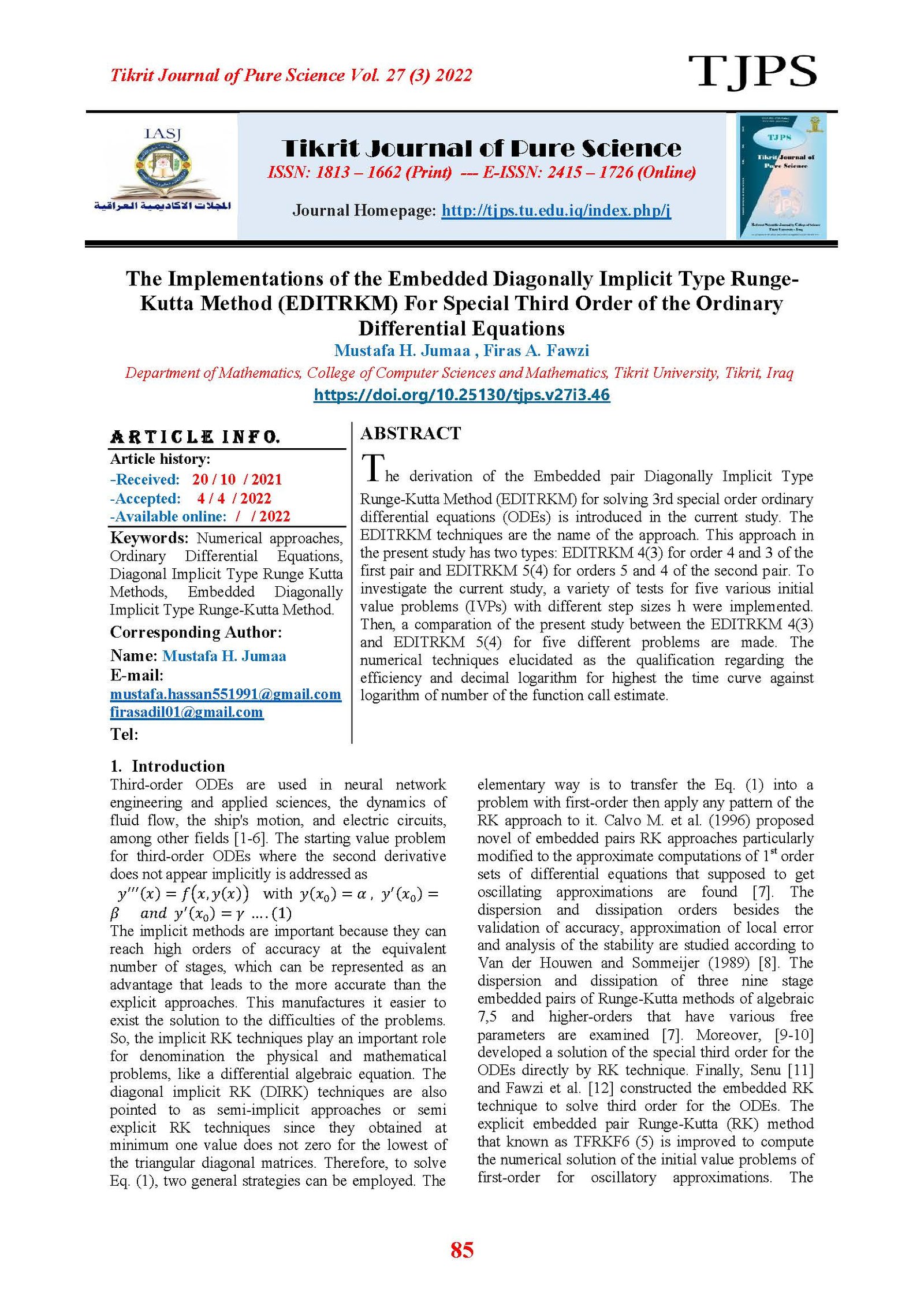The Implementations of the Embedded Diagonally Implicit Type Runge-Kutta Method (EDITRKM) For Special Third Order of the Ordinary Differential Equations
Main Article Content
Abstract
The derivation of the Embedded pair Diagonally Implicit Type Runge-Kutta Method (EDITRKM) for solving 3rd special order ordinary differential equations (ODEs) is introduced in the current study. The EDITRKM techniques are the name of the approach. This approach in the present study has two types: EDITRKM 4(3) for order 4 and 3 of the first pair and EDITRKM 5(4) for orders 5 and 4 of the second pair. To investigate the current study, a variety of tests for five various initial value problems (IVPs) with different step sizes h were implemented. Then, a comparation of the present study between the EDITRKM 4(3) and EDITRKM 5(4) for five different problems are made. The numerical techniques elucidated as the qualification regarding the efficiency and decimal logarithm for highest the time curve against logarithm of number of the function call estimate.
Article Details

This work is licensed under a Creative Commons Attribution 4.0 International License.
Tikrit Journal of Pure Science is licensed under the Creative Commons Attribution 4.0 International License, which allows users to copy, create extracts, abstracts, and new works from the article, alter and revise the article, and make commercial use of the article (including reuse and/or resale of the article by commercial entities), provided the user gives appropriate credit (with a link to the formal publication through the relevant DOI), provides a link to the license, indicates if changes were made, and the licensor is not represented as endorsing the use made of the work. The authors hold the copyright for their published work on the Tikrit J. Pure Sci. website, while Tikrit J. Pure Sci. is responsible for appreciate citation of their work, which is released under CC-BY-4.0, enabling the unrestricted use, distribution, and reproduction of an article in any medium, provided that the original work is properly cited.
References
[1] W. X. Jian, Y. Wang, and W. G. Price. Multiple resonances, responses, and parametric instabilities in offshore structures. Journal of ship research 32.04 (1988): 285-296.
[2] R. Cortell. Application of the fourth-order Runge-Kutta method for the solution of high-order general initial value problems. Computers & structures 49.5 (1993): 897-900.
[3] M. Alaeddin, and R. S. Beidokhti. Numerical solution for high order differential equations using a hybrid neural network—optimization method. Applied Mathematics and Computation 183.1 (2006): 260-271.
[4] A. Boutayeb and A. Chetouani. A mini-review of numerical methods for high-order problems. International Journal of Computer Mathematics 84.4 (2007): 563-579.
[5] A. K. Alomarin et al. Approximate solution of nonlinear system of BVP arising in fluid flow problem. Mathematical Problems in Engineering 2013 (2013).
[6] E. H. Twizell. A family of numerical methods for the solution of high-order general initial value problems." Computer methods in applied mechanics and engineering 67.1 (1988): 15-25.
[7] M. Calvo et al. Explicit Runge-Kutta methods for initial value problems with oscillating solutions. Journal of computational and applied mathematics 76.1-2 (1996): 195-212.
[8] V. D. Houwen, P. Jacobus, et al. On the numerical integration of second-order initial value problems with a periodic forcing function. Computing 37.3 (1986): 195-218.
[9] F. A. Fawzi, et al. A New Integrator of Runge-Kutta Type for Directly Solving General Third-order ODEs with Application to Thin Film Flow Problem Applied Mathematics & Information Sciences 12 (4) (2018): 775-784.
[10] F. A. Fawzi, et al. An efficient of direct integrator of Runge-Kutta type method for solving
